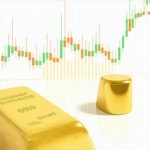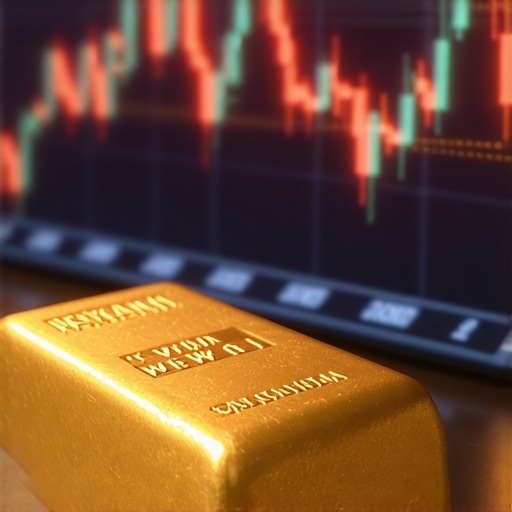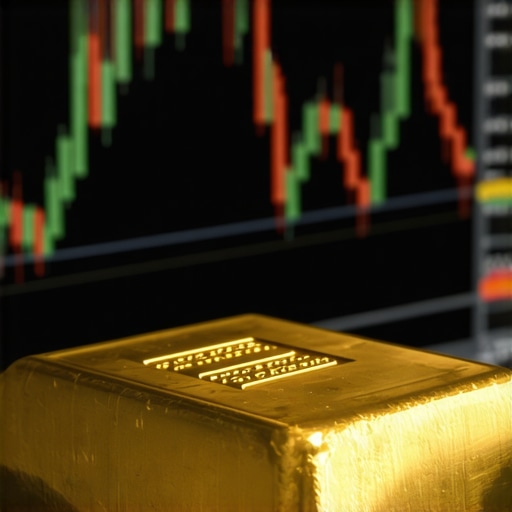Understanding Gold Price Trends and Their Future Impact on Investors
Gold has always been a safe haven for investors, especially during times of economic uncertainty. As we look forward to the coming year, understanding gold price trends will be crucial for both seasoned and new investors alike. This article will delve into various factors influencing gold prices and what trends can be expected in the near future.
The Current Landscape of Gold Prices
In recent years, we have witnessed significant fluctuations in gold prices. Factors such as inflation, global political tensions, and changes in interest rates have all played pivotal roles. For instance, as inflation rises, many investors flock to gold as a hedge against the eroding purchasing power of their money. This trend is likely to continue, as inflation concerns remain prevalent on a global scale.
Global Economic Indicators Affecting Gold Prices
The gold market is highly sensitive to global economic indicators. Key metrics such as employment data, GDP growth rates, and central bank policies can greatly influence gold prices. For example, when economic growth slows, demand for gold often increases as investors seek stability. Understanding these indicators can help investors better anticipate gold price movements.
Technological Advancements and Gold Investments
Moreover, advancements in technology have opened new avenues for gold investment. The rise of gold ETFs (Exchange-Traded Funds) has made it easier for investors to gain exposure to gold without physically holding the metal. This trend is expected to grow, as more investors seek convenient and diversified ways to invest in gold. You can learn more about the implications of investing in ETFs through our article on Gold ETFs vs. Gold Mutual Funds.
Expert Predictions for Gold Prices in the Coming Year
Looking ahead, experts are predicting an upward trend in gold prices due to ongoing global economic uncertainties. Factors such as geopolitical tensions, central bank policies, and fluctuating demand from emerging markets will continue to shape the gold market landscape. If you want to explore expert opinions, you can check our detailed post on 2025 Gold Price Forecasts.
Conclusion: Preparing for Future Gold Investments
As we navigate through these trends, it is essential for investors to stay informed and prepared. Understanding the dynamics of gold price trends not only helps in making informed decisions but also enhances the potential for profitable investments. By staying abreast of market movements and expert analyses, investors can position themselves strategically for the opportunities that lie ahead.
Factors Influencing Future Gold Price Trends
As we delve deeper into the intricacies of the gold market, it is crucial to identify the fundamental factors that will shape future gold price trends. Investors should closely monitor geopolitical events, economic policies, and market sentiment, all of which can significantly impact gold prices.
The Role of Geopolitical Tensions in Gold Valuation
Geopolitical tensions have historically driven gold prices higher as investors seek safe-haven assets. Current events, such as trade disputes and military conflicts, often lead to increased demand for gold. For instance, during times of uncertainty, many investors look for stability, turning to gold as a secure investment option. Keeping abreast of global political developments can provide valuable insights into potential price fluctuations.
Inflation and Its Impact on Gold Prices
Inflation remains a critical factor in determining the value of gold. As the cost of living rises, the purchasing power of currency declines, prompting investors to flock to tangible assets like gold. This trend is particularly evident during periods of high inflation when central banks may adopt looser monetary policies. Investors should consider how inflationary pressures influence gold as a hedge against currency depreciation. For a detailed analysis on this topic, explore our post on Why Gold is Essential for Hedging Against Inflation.
Central Bank Policies and Gold Demand
Central banks play a pivotal role in shaping gold demand through their monetary policies. When central banks adopt low-interest rates or implement quantitative easing, it tends to increase gold investment as the opportunity cost of holding gold decreases. Understanding these policies can provide investors with a clearer picture of future gold price movements. For more insights on central bank actions, consider reading our piece on Central Bank Gold Purchases: Impact on the Market.
Investment Strategies for the Changing Gold Market
Adapting investment strategies in response to changing market conditions is essential for maximizing returns. Properly positioning one’s portfolio can lead to significant gains, especially in a volatile gold market.
Diversifying Gold Investment Types
Investors should consider diversifying their gold investments across various forms, such as physical gold, ETFs, and gold mining stocks. Each type offers unique benefits and risks. For instance, while physical gold provides tangible ownership, gold ETFs offer liquidity and ease of trading. A well-rounded approach allows investors to mitigate risks and optimize returns. Check out our comprehensive overview on Diverse Types of Gold Investments: A Comprehensive Overview for more details.
Utilizing Effective Trading Techniques
Implementing effective trading techniques is vital for navigating the gold market successfully. Traders should focus on key indicators, such as moving averages and momentum indicators, to inform their trading decisions. Furthermore, understanding market psychology can enhance trading strategies, allowing for better timing of buy and sell decisions. For advanced strategies, refer to our article on Advanced Gold Trading Techniques for Serious Investors.
Conclusion: Positioning for Success in Gold Investments
In summary, staying informed about market trends, geopolitical developments, and economic indicators is crucial for gold investors. By diversifying investment types and employing effective trading techniques, investors can position themselves for success in the evolving gold market. As we approach future uncertainties, understanding these dynamics will enhance the potential for achieving lucrative returns in gold investments.
Understanding Gold Investment Returns: Key Metrics to Monitor
To effectively gauge the potential of your gold investments, it’s essential to understand the key metrics that influence returns. These metrics include the historical performance of gold, current economic indicators, and global market conditions. By analyzing these elements, investors can make informed decisions that align with their financial goals.
Evaluating Historical Gold Performance
Gold has exhibited a historical trend of value appreciation, especially during economic downturns. Observing past performance can provide insights into potential future movements. For instance, periods of financial instability often see a surge in gold prices as investors flock to safe-haven assets. Understanding these historical patterns can help you anticipate market behavior and adjust your investment strategy accordingly.
Current Economic Indicators Affecting Gold
Current economic indicators, such as inflation rates, interest rates, and employment data, play a significant role in shaping gold prices. For example, rising inflation typically boosts demand for gold as a hedge against currency devaluation. Monitoring these indicators can help you stay ahead in the gold market. To deepen your knowledge of inflation’s impact on gold, you might find our article on Why Gold is Essential for Hedging Against Inflation particularly insightful.
Key Strategies for Investing in Gold in 2025
As the gold market evolves, adopting effective investment strategies becomes essential for maximizing returns. Here are some key approaches to consider for gold investments in 2025.
Investing in Gold ETFs vs. Physical Gold
Deciding between gold ETFs and physical gold is a significant consideration for investors. Gold ETFs offer liquidity and lower transaction costs, making them an attractive option for many. Conversely, physical gold provides tangible value and can be beneficial during times of economic uncertainty. Weighing the pros and cons of each can help you determine which investment aligns best with your financial strategy. For more details, check out our post on Physical Gold vs. ETFs: Which Investment is Smarter?.
Utilizing Options and Futures for Enhanced Returns
For more advanced investors, options and futures trading can enhance gold investment returns. These financial instruments allow investors to leverage their positions, potentially leading to higher profits. However, they also come with increased risks, so it’s crucial to have a solid understanding of the market before diving in. For strategies on trading techniques, consider reading our article on Advanced Gold Trading Techniques for Serious Investors.
Conclusion: Preparing for a Robust Gold Investment Future
In conclusion, maximizing gold investment returns requires a comprehensive understanding of market dynamics, strategic diversification, and the careful selection of investment vehicles. By monitoring key economic indicators and adopting effective trading strategies, investors can position themselves for success in the evolving gold market landscape. As we look forward to 2025, staying informed and adaptable will be paramount for achieving your investment goals in the gold sector.
Understanding Gold Investment Trends in 2025
As we venture into 2025, understanding the trends that shape the gold market is crucial for every investor. The fluctuating demand for gold is influenced by various factors, including geopolitical tensions, market speculation, and changing economic conditions. Staying informed about these trends enables investors to make strategic decisions that optimize their portfolios.
Geopolitical Factors Influencing Gold Prices
Gold often acts as a safe-haven asset during geopolitical uncertainties. Events such as conflicts, trade tensions, or significant political changes can lead to increased demand for gold, resulting in price surges. Investors should keep an eye on global news and market sentiments, which can provide insights into potential price movements. For a deeper understanding of how these events impact prices, refer to our analysis on Gold Market Analysis: Key Players and Their Impact.
Technological Advances in Gold Trading
The rise of technology has revolutionized gold trading, making it more accessible to a broader audience. Online trading platforms and mobile applications enable investors to buy and sell gold with ease, enhancing liquidity and reducing costs. Familiarizing yourself with these technological tools can improve your investment strategy. Explore our guide on Essential Gold Trading Techniques for Beginners in 2025 to learn more about leveraging technology in your investments.
Diversifying Your Gold Investment Portfolio
Diversification is a cornerstone of successful investing, and this principle applies to gold investments as well. By spreading your investments across different types of gold assets, you can mitigate risks and enhance overall returns.
Exploring Different Types of Gold Investments
Investors can choose from various gold investment options, including gold bars, coins, ETFs, and mining stocks. Each type has its unique benefits and risks. For instance, while gold coins offer tangible value, gold ETFs provide liquidity and ease of trading. Understanding the characteristics of each will help you decide which investments align with your risk tolerance and financial goals. Dive deeper into this topic by reading our post on Types of Gold Investments: Which One is Right for You?.
Combining Gold with Other Asset Classes
Integrating gold into a diversified investment portfolio can enhance performance and provide stability. Gold often exhibits a negative correlation with traditional assets like stocks and bonds. Therefore, during market downturns, gold may retain its value, acting as a buffer against losses. For insights on how to balance your portfolio, our article on The Role of Gold in a Balanced Investment Portfolio is highly recommended.
Conclusion: Future-Proofing Your Gold Investments
Preparing for the future of gold investments requires ongoing education and strategic planning. By understanding market trends, diversifying your portfolio, and utilizing advanced trading techniques, you can maximize your returns and secure your financial future. As we look ahead to 2025, remain adaptable to changes in the market, and continually seek out new opportunities to enhance your gold investment strategy.
Comprehensive FAQ on Gold Investments
What are the main benefits of investing in gold in 2025?
Investing in gold offers several benefits, including portfolio diversification, protection against inflation, and a hedge against economic uncertainty. As a safe-haven asset, gold tends to retain its value during market volatility, making it a strategic choice for investors looking to stabilize their portfolios.
How can I start investing in gold?
To start investing in gold, you can choose from various options such as physical gold (bars and coins), gold ETFs, or gold mining stocks. Research the different types of investments, evaluate your financial goals, and select the option that best aligns with your investment strategy.
Is gold a reliable investment during economic downturns?
Yes, gold is often considered a reliable investment during economic downturns due to its historical performance. It typically maintains or increases in value when other asset classes, such as stocks or bonds, experience declines. Investors often flock to gold in times of uncertainty, reinforcing its status as a safe-haven asset.
What are the risks of investing in gold?
While gold can be a stable investment, it is not without risks. Price volatility, storage costs for physical gold, and market speculation can impact returns. Additionally, gold does not generate income like dividends or interest, so investors should consider these factors when adding gold to their portfolios.
How do I determine the right amount of gold to include in my portfolio?
Determining the right amount of gold to include in your portfolio depends on your overall investment strategy, risk tolerance, and financial goals. A common recommendation is to allocate between 5-10% of your total investment portfolio to gold to achieve diversification without overexposing yourself to its risks.
What are the signs that gold prices may rise?
Several indicators can signal potential rises in gold prices, including geopolitical tensions, inflationary pressures, and changes in central bank policies. Monitoring economic indicators, currency strength, and investor sentiment can also provide clues about future gold price movements.
Can I invest in gold through my retirement account?
Yes, you can invest in gold through a self-directed IRA (SDIRA). This allows you to include physical gold or gold-backed securities as part of your retirement portfolio. Ensure you consult with a financial advisor to understand the rules and regulations surrounding gold investments in retirement accounts.
How can I keep up with gold market trends?
Staying informed about gold market trends can be achieved through various resources, including financial news websites, market analysis reports, and expert blogs. Subscribing to newsletters and following industry experts on social media can also help you stay updated on important developments.
What are the tax implications of selling gold?
Selling gold can have tax implications, as it is considered a collectible by the IRS. Profits from the sale of gold may be subject to capital gains tax, depending on how long you held the asset. Consult a tax professional to understand how selling gold could impact your tax situation.
Where can I find reliable information on gold investments?
Reliable information on gold investments can be found through reputable financial news outlets, investment blogs, and resources from established financial institutions. Websites such as Kitco, World Gold Council, and Investopedia provide valuable insights and analysis on the gold market.
Authority Resources for Gold Investment Information
For those seeking to deepen their understanding of gold investments, several trusted resources offer expert insights and comprehensive data:
- Kitco – A leading provider of precious metals information, offering market news, prices, and analysis.
- World Gold Council – The market development organization for the gold industry, providing research and data on gold supply and demand.
- Investopedia – A comprehensive resource for investing education, featuring articles on gold investment strategies and market trends.
- Bloomberg – Financial news and data provider with extensive coverage of gold markets and economic factors influencing gold prices.
- Reuters – A global news organization that covers economic news, including analysis on gold prices and market trends.
Conclusion: Your Path to Successful Gold Investments
As we navigate the complexities of the gold investment landscape in 2025, understanding market trends, diversifying your portfolio, and leveraging technology are essential strategies for maximizing returns. By staying informed and utilizing resources from trusted authorities, you can confidently approach your gold investments. Remember, gold serves not only as a hedge against uncertainty but also as a vital component of a well-rounded investment strategy. Embrace the opportunities that gold offers to secure your financial future.











The detailed discussion on how inflation and central bank policies impact gold prices really resonated with me. I’ve noticed that during periods of aggressive monetary easing, gold tends to rally because the opportunity cost of holding non-yielding assets decreases. This article also rightly highlights the growing appeal of gold ETFs, which I have personally used to diversify my portfolio without dealing with the complexities of storing physical gold. However, I think it’s equally important for investors to consider geopolitical developments since even minor political tensions can trigger significant volatility in gold markets. The section about combining different gold investment types to balance risk is crucial; physical gold offers security, but ETFs provide liquidity and ease of trading. For anyone considering gold as a hedge against inflation or economic uncertainty in 2025, understanding these nuanced factors is vital for crafting a resilient investment strategy. Overall, the post provides a comprehensive overview that captures the multi-faceted nature of gold investment trends efficiently.
I find the discussion on the influence of geopolitical tensions on gold valuation particularly compelling. In my experience, these uncertainties often prompt investors to seek gold as a stable haven, as the article points out. However, I’ve noticed that such geopolitical shocks can sometimes lead to rapid and unpredictable price movements, making timing critical for investors. Additionally, the rise of gold ETFs has undeniably transformed how many of us engage with gold investments, offering both flexibility and accessibility. Yet, I often wonder about the long-term implications of relying heavily on ETFs versus holding physical gold, especially in volatile markets. For instance, physical gold, while less liquid, offers a tangible asset that isn’t subject to some of the risks linked with ETFs, such as market liquidity or counterparty risk. Given this, how do seasoned investors balance these considerations when structuring their gold portfolios? Also, with technology enabling easier access to gold trading platforms, is there a risk that increased speculation might add to market volatility? I’d be interested to hear how others navigate these nuances, especially as we head into potentially uncertain economic times.
This article provides a comprehensive overview of the factors influencing gold prices and aligns well with what I’ve observed in recent years. The emphasis on geopolitical tensions and inflation’s impact is particularly relevant, as these elements have increasingly driven market volatility. I’ve noticed that during periods of heightened global uncertainty, investors tend to flock to gold, which often results in quick price spikes. However, I think one challenge for individual investors is timing these movements accurately. It raises the question: how can investors better leverage technological tools and market indicators to predict these shifts? I’ve found that utilizing real-time data from trusted sources like Kitco or the World Gold Council helps me stay informed, but I’m curious about more advanced strategies—maybe options or futures—that can offer more precise control. Have any investors here had success with predictive analytics or alternative techniques to optimize their gold investment timing? It seems like combining fundamental analysis with technological insights might be the key going forward.